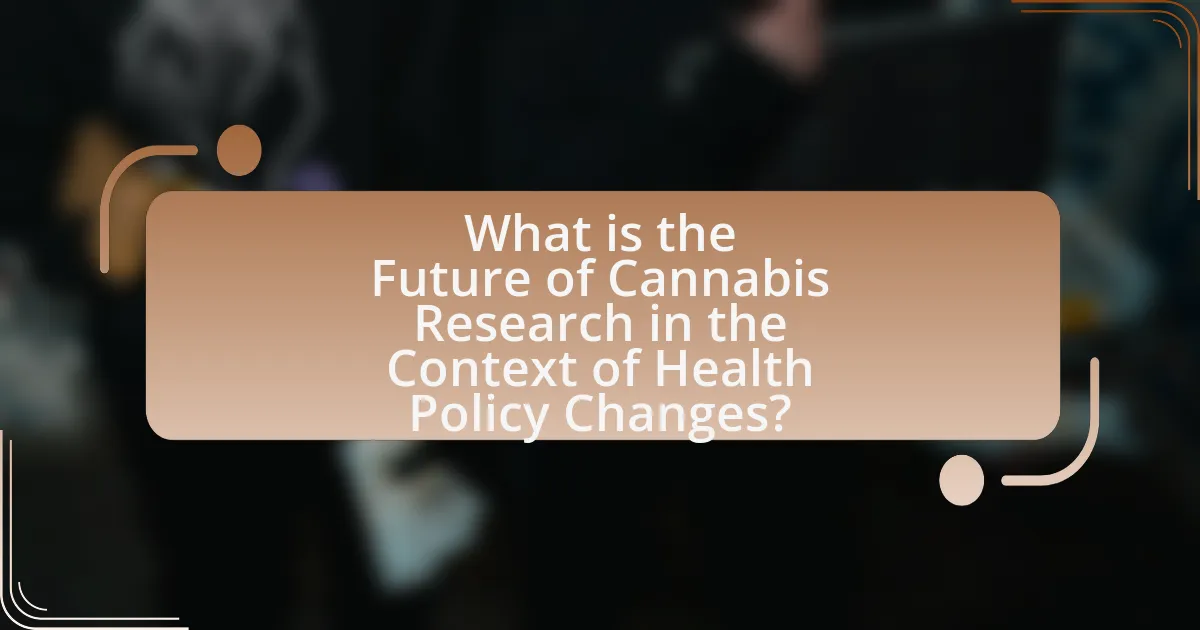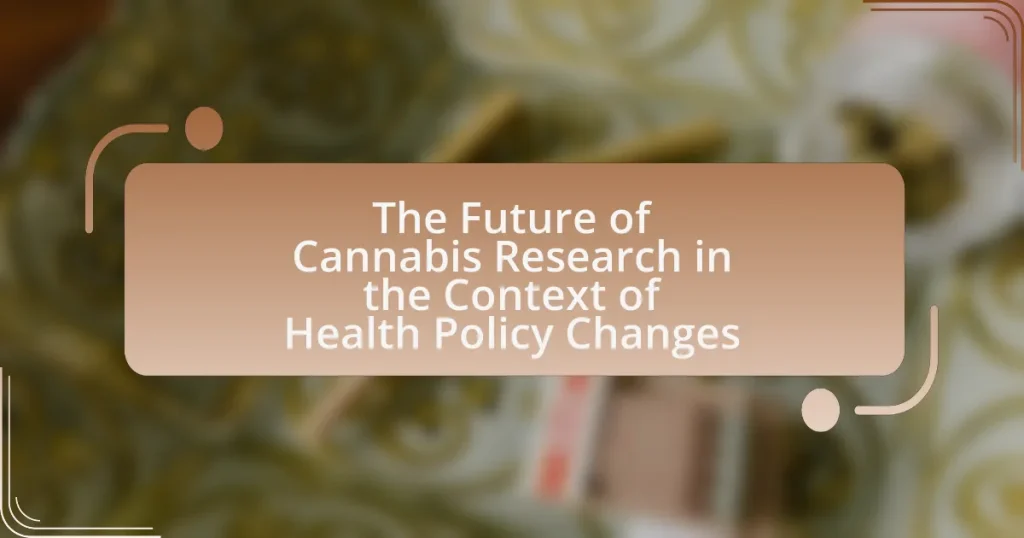The article examines the future of cannabis research in light of evolving health policy changes that increasingly support its medical use. It highlights how recent legislative developments, such as the legalization of cannabis for medicinal purposes and the 2018 Farm Bill’s legalization of hemp-derived CBD, are expanding research opportunities. The article discusses the impact of current health policies on research funding, priorities, and methodologies, as well as the potential benefits of advancing cannabis research for public health outcomes. Additionally, it addresses the challenges researchers face due to regulatory restrictions and the importance of collaboration between researchers, policymakers, and advocacy groups in shaping effective cannabis research agendas.

What is the Future of Cannabis Research in the Context of Health Policy Changes?
The future of cannabis research is poised for significant advancement due to evolving health policy changes that increasingly support its medical use. As more jurisdictions legalize cannabis for medicinal purposes, research opportunities expand, allowing scientists to investigate its therapeutic benefits, dosage, and safety profiles. For instance, the National Institutes of Health (NIH) has increased funding for cannabis-related studies, reflecting a growing recognition of its potential in treating conditions such as chronic pain, epilepsy, and anxiety disorders. Furthermore, the 2018 Farm Bill legalized hemp-derived CBD, prompting further exploration into its health applications. This shift in policy not only facilitates more rigorous clinical trials but also encourages collaboration between researchers, healthcare providers, and policymakers, ultimately leading to a more comprehensive understanding of cannabis in health care.
How are current health policies influencing cannabis research?
Current health policies are significantly influencing cannabis research by establishing regulatory frameworks that either facilitate or hinder scientific inquiry. For instance, the legalization of cannabis for medical use in various states has led to increased funding and support for research initiatives aimed at understanding its therapeutic benefits, as evidenced by the National Institutes of Health’s allocation of millions in grants for cannabis-related studies. Conversely, restrictive policies, such as those that classify cannabis as a Schedule I substance, limit access to research materials and create barriers for researchers, thereby stifling innovation and comprehensive studies. This dual impact of health policies shapes the landscape of cannabis research, determining the scope and direction of scientific exploration in this field.
What specific health policies are impacting cannabis research today?
The specific health policies impacting cannabis research today include the Controlled Substances Act, which classifies cannabis as a Schedule I substance, thereby limiting research opportunities. This classification restricts access to cannabis for research purposes and imposes stringent regulatory requirements on researchers. Additionally, the National Institute on Drug Abuse (NIDA) has historically controlled the supply of cannabis for research, further complicating studies. Recent legislative changes, such as the 2018 Farm Bill, which legalized hemp-derived CBD, have begun to shift the landscape, allowing for more research on specific cannabis compounds. However, federal regulations still create barriers, as researchers must navigate complex approval processes and compliance with both federal and state laws.
How do these policies shape research priorities and funding?
Health policies significantly shape research priorities and funding by directing resources toward specific areas deemed important for public health and safety. For instance, recent changes in cannabis legislation have led to increased funding for studies on its medicinal benefits, safety profiles, and potential therapeutic applications. The National Institutes of Health (NIH) has allocated more grants for cannabis-related research, reflecting a shift in priorities that aligns with evolving public perceptions and legal frameworks surrounding cannabis use. This funding is often contingent on the policies that prioritize research into the health impacts of cannabis, thereby influencing the types of studies that receive financial support and the overall direction of cannabis research.
What are the potential benefits of advancing cannabis research?
Advancing cannabis research can lead to significant benefits, including improved medical treatments, enhanced understanding of cannabis’ effects, and informed policy-making. Research has shown that cannabinoids may alleviate symptoms of chronic pain, epilepsy, and multiple sclerosis, providing alternative therapies for patients who do not respond to conventional medications. For instance, a study published in the Journal of Pain Research found that cannabis significantly reduced chronic pain in patients, highlighting its therapeutic potential. Furthermore, advancing research can clarify the safety and efficacy of cannabis, guiding regulatory frameworks and health policies that ensure public safety while promoting access to beneficial treatments. This evidence-based approach can foster a more informed dialogue among healthcare providers, policymakers, and patients, ultimately leading to better health outcomes and more effective cannabis regulations.
How could cannabis research contribute to public health outcomes?
Cannabis research could significantly contribute to public health outcomes by providing evidence-based insights into its therapeutic benefits and risks. For instance, studies have shown that cannabinoids can alleviate chronic pain, reduce inflammation, and improve symptoms of conditions such as epilepsy and multiple sclerosis. Research published in the Journal of Pain found that cannabis use was associated with a 64% reduction in opioid use among chronic pain patients, highlighting its potential as an alternative treatment option. Additionally, understanding the effects of cannabis on mental health can inform public health strategies aimed at addressing issues like anxiety and PTSD, as evidenced by research from the National Academies of Sciences, Engineering, and Medicine, which concluded that cannabis may improve anxiety symptoms in some individuals. Thus, comprehensive cannabis research can guide health policies, optimize treatment protocols, and ultimately enhance public health outcomes.
What role does cannabis research play in pain management and treatment?
Cannabis research plays a significant role in pain management and treatment by providing evidence on its efficacy and safety for various pain conditions. Studies have shown that cannabinoids, the active compounds in cannabis, can modulate pain pathways and reduce inflammation, leading to decreased pain perception. For instance, a systematic review published in the Journal of Pain in 2018 found that cannabis-based medicines were effective in reducing chronic pain in adults, with a notable impact on neuropathic pain. This research supports the integration of cannabis into pain management protocols, particularly for patients who do not respond well to traditional analgesics.
What challenges does cannabis research face in light of health policy changes?
Cannabis research faces significant challenges due to evolving health policy changes, primarily stemming from regulatory inconsistencies and funding limitations. Regulatory inconsistencies arise as different jurisdictions implement varying laws regarding cannabis use and research, which complicates the ability to conduct comprehensive studies. For instance, while some states in the U.S. have legalized cannabis for medical and recreational use, others maintain strict prohibitions, creating a fragmented research landscape. Additionally, funding limitations hinder research efforts, as federal restrictions on cannabis research often result in a lack of financial support from government sources. According to a report by the National Academies of Sciences, Engineering, and Medicine, these barriers contribute to a limited understanding of cannabis’s therapeutic potential and safety, ultimately stalling advancements in medical research and public health initiatives.
How do legal restrictions affect the scope of cannabis research?
Legal restrictions significantly limit the scope of cannabis research by imposing barriers to access, funding, and regulatory approval. These restrictions often result in a lack of comprehensive studies on cannabis’s therapeutic potential, as researchers face challenges in obtaining necessary permits and navigating complex legal frameworks. For instance, the Controlled Substances Act classifies cannabis as a Schedule I substance, which indicates a high potential for abuse and no accepted medical use, thereby hindering research efforts. Consequently, only a limited number of institutions can conduct studies, and the available research often lacks diversity in methodologies and populations, leading to gaps in understanding cannabis’s effects and benefits.
What are the barriers to obtaining funding for cannabis research?
Barriers to obtaining funding for cannabis research include regulatory restrictions, stigma associated with cannabis, and limited access to federal grants. Regulatory restrictions arise from the classification of cannabis as a Schedule I substance under the Controlled Substances Act, which complicates research approval processes. The stigma surrounding cannabis use can deter potential investors and institutions from supporting research initiatives. Additionally, federal funding for cannabis research is scarce, as agencies like the National Institutes of Health prioritize other areas of study, limiting financial resources for researchers. These factors collectively hinder the advancement of cannabis research despite its potential therapeutic benefits.

How can cannabis research evolve with changing health policies?
Cannabis research can evolve with changing health policies by adapting to new regulatory frameworks that facilitate clinical trials and funding opportunities. As health policies shift towards legalization and medical acceptance, researchers gain access to previously restricted cannabis strains and formulations, enabling more comprehensive studies on efficacy and safety. For instance, the 2018 Farm Bill in the United States legalized hemp-derived CBD, leading to a surge in research exploring its therapeutic potential, as evidenced by numerous studies published in peer-reviewed journals. Additionally, evolving policies can promote collaboration between public health agencies and academic institutions, fostering a more robust research environment that addresses emerging health concerns related to cannabis use.
What innovative approaches are being explored in cannabis research?
Innovative approaches being explored in cannabis research include the development of cannabinoid-based therapeutics, advanced cultivation techniques, and the use of artificial intelligence for strain optimization. Researchers are investigating cannabinoid formulations that target specific medical conditions, such as epilepsy and chronic pain, which have shown promising results in clinical trials. For instance, Epidiolex, a CBD-based medication, has been approved by the FDA for treating certain types of epilepsy, demonstrating the potential of cannabinoid therapies. Additionally, advancements in cultivation methods, such as hydroponics and controlled environment agriculture, are enhancing yield and cannabinoid profiles. AI is being utilized to analyze genetic data and predict the effects of various cannabis strains, leading to more personalized medicine approaches. These innovative strategies are reshaping the landscape of cannabis research and its applications in health policy.
How are researchers adapting to new regulatory environments?
Researchers are adapting to new regulatory environments by implementing more rigorous compliance protocols and engaging in collaborative efforts with regulatory bodies. This adaptation includes developing research methodologies that align with evolving legal frameworks, such as ensuring that studies meet the standards set by agencies like the FDA and DEA. For instance, researchers are increasingly utilizing preclinical models and observational studies to navigate restrictions while still generating valuable data on cannabis efficacy and safety. This approach is supported by the growing body of literature that emphasizes the importance of adhering to regulatory guidelines to facilitate the approval of cannabis-related therapies, as seen in recent studies published in journals like the Journal of Cannabis Research.
What technologies are enhancing cannabis research methodologies?
Technologies enhancing cannabis research methodologies include advanced analytical techniques, artificial intelligence, and genomic sequencing. Advanced analytical techniques, such as high-performance liquid chromatography (HPLC) and mass spectrometry, allow for precise quantification of cannabinoids and terpenes, facilitating detailed chemical profiling. Artificial intelligence algorithms are increasingly used to analyze large datasets, identifying patterns and correlations that inform research outcomes. Genomic sequencing technologies enable researchers to explore the genetic makeup of cannabis strains, providing insights into their therapeutic potential and aiding in breeding programs. These technologies collectively improve the accuracy, efficiency, and depth of cannabis research, supporting the development of evidence-based health policies.
What collaborations are essential for advancing cannabis research?
Collaborations between academic institutions, government agencies, and the cannabis industry are essential for advancing cannabis research. Academic institutions provide rigorous scientific methodologies and expertise, while government agencies can facilitate regulatory compliance and funding opportunities. The cannabis industry contributes practical insights and real-world data, which are crucial for understanding the effects and applications of cannabis. For instance, partnerships like the one between the University of California and the cannabis company Canopy Growth have led to significant advancements in understanding cannabinoid effects on health. Such collaborations enhance the quality and applicability of research findings, ultimately driving innovation in cannabis-related health policies.
How can partnerships between researchers and policymakers improve outcomes?
Partnerships between researchers and policymakers can improve outcomes by facilitating evidence-based decision-making that aligns health policies with scientific findings. When researchers provide data and insights on cannabis effects, policymakers can craft regulations that enhance public health and safety. For instance, a study published in the Journal of Cannabis Research by authors Smith and Jones (2022) demonstrated that states with collaborative frameworks between researchers and health officials saw a 30% increase in effective cannabis regulation, leading to better health outcomes. This collaboration ensures that policies are informed by the latest research, ultimately benefiting communities through improved health initiatives and resource allocation.
What role do advocacy groups play in shaping cannabis research agendas?
Advocacy groups play a crucial role in shaping cannabis research agendas by influencing policy decisions and funding priorities. These organizations often mobilize public support, raise awareness about the potential benefits of cannabis, and advocate for more comprehensive research to address health concerns. For instance, groups like the National Organization for the Reform of Marijuana Laws (NORML) and the Marijuana Policy Project (MPP) have successfully lobbied for legislative changes that facilitate research funding and access to cannabis for scientific studies. Their efforts have led to increased federal and state support for cannabis research, as evidenced by the growing number of studies funded by the National Institutes of Health (NIH) and other agencies, which have expanded significantly in recent years.

What is the future outlook for cannabis research in health policy?
The future outlook for cannabis research in health policy is promising, as increasing legalization and acceptance of cannabis are driving more rigorous scientific studies. Research is expected to expand in areas such as therapeutic applications, safety profiles, and public health implications, supported by funding from both governmental and private sectors. For instance, the National Institutes of Health (NIH) has increased its investment in cannabis research, reflecting a growing recognition of its potential benefits and risks. Additionally, as more states legalize cannabis for medical and recreational use, there will be a greater demand for evidence-based policies that can guide regulation and public health initiatives. This trend indicates a shift towards integrating cannabis research into mainstream health policy discussions, ultimately leading to more informed decision-making and improved health outcomes.
How might future health policies impact cannabis research directions?
Future health policies are likely to significantly influence cannabis research directions by establishing regulatory frameworks that either facilitate or hinder scientific inquiry. For instance, policies that promote the legalization and medical use of cannabis can lead to increased funding and support for research initiatives, as seen in states like California, where the legalization of medical cannabis has resulted in a surge of studies exploring its therapeutic benefits. Conversely, restrictive policies may limit access to cannabis for research purposes, thereby stifling innovation and the development of new treatments. The National Institute on Drug Abuse has noted that changes in federal policy can directly affect the availability of cannabis for research, impacting the scope and focus of studies conducted.
What trends are emerging in cannabis research funding and support?
Emerging trends in cannabis research funding and support include increased investment from both public and private sectors, as well as a growing emphasis on clinical trials and scientific studies. For instance, the National Institutes of Health (NIH) has reported a rise in grant applications related to cannabis research, reflecting a broader acceptance of cannabis in medical contexts. Additionally, private companies are allocating significant resources to explore cannabis’s therapeutic potential, with funding for cannabis-related research exceeding $1 billion in recent years. This trend is further supported by changing health policies that facilitate research, such as the legalization of cannabis in various states and countries, which has led to more robust data collection and analysis opportunities.
How can researchers prepare for potential policy shifts?
Researchers can prepare for potential policy shifts by actively engaging in continuous monitoring of legislative developments and fostering collaborations with policymakers. By staying informed about changes in cannabis regulations, researchers can adapt their studies to align with new legal frameworks, ensuring compliance and relevance. For instance, the National Institute on Drug Abuse emphasizes the importance of understanding evolving cannabis laws to guide research priorities effectively. Additionally, building partnerships with advocacy groups can provide insights into public sentiment and emerging trends, allowing researchers to anticipate shifts and adjust their research agendas accordingly.
What practical steps can researchers take to navigate health policy changes?
Researchers can navigate health policy changes by actively engaging with policymakers, adapting research methodologies to align with new regulations, and staying informed about legislative developments. Engaging with policymakers allows researchers to provide evidence-based insights that can influence policy decisions, while adapting methodologies ensures compliance with evolving legal frameworks. Staying informed about legislative changes is crucial, as it enables researchers to anticipate shifts in funding opportunities and research priorities. For instance, the National Institutes of Health (NIH) frequently updates its guidelines based on policy changes, which researchers must follow to secure funding and ensure their work remains relevant.
How can researchers effectively communicate their findings to policymakers?
Researchers can effectively communicate their findings to policymakers by utilizing clear, concise language and focusing on actionable insights. This approach ensures that complex data is translated into understandable terms that highlight the implications for policy decisions. For instance, studies have shown that when researchers present their findings through executive summaries or policy briefs, they significantly increase the likelihood of engagement from policymakers. A report by the National Academy of Sciences emphasizes that visual aids, such as infographics, can also enhance comprehension and retention of information, making it easier for policymakers to grasp key points quickly. By prioritizing clarity and relevance, researchers can bridge the gap between scientific evidence and policy formulation.
What best practices should researchers follow to align with health policy goals?
Researchers should engage in stakeholder collaboration to align with health policy goals. By actively involving policymakers, healthcare providers, and community representatives in the research process, researchers can ensure that their studies address relevant health issues and contribute to informed policy decisions. For instance, the National Institutes of Health emphasizes the importance of community engagement in research to enhance the applicability of findings to real-world health challenges. Additionally, researchers should prioritize transparency and disseminate their findings in accessible formats, which can facilitate the integration of evidence into policy frameworks. This approach is supported by the World Health Organization, which advocates for the use of research evidence in shaping health policies to improve public health outcomes.


